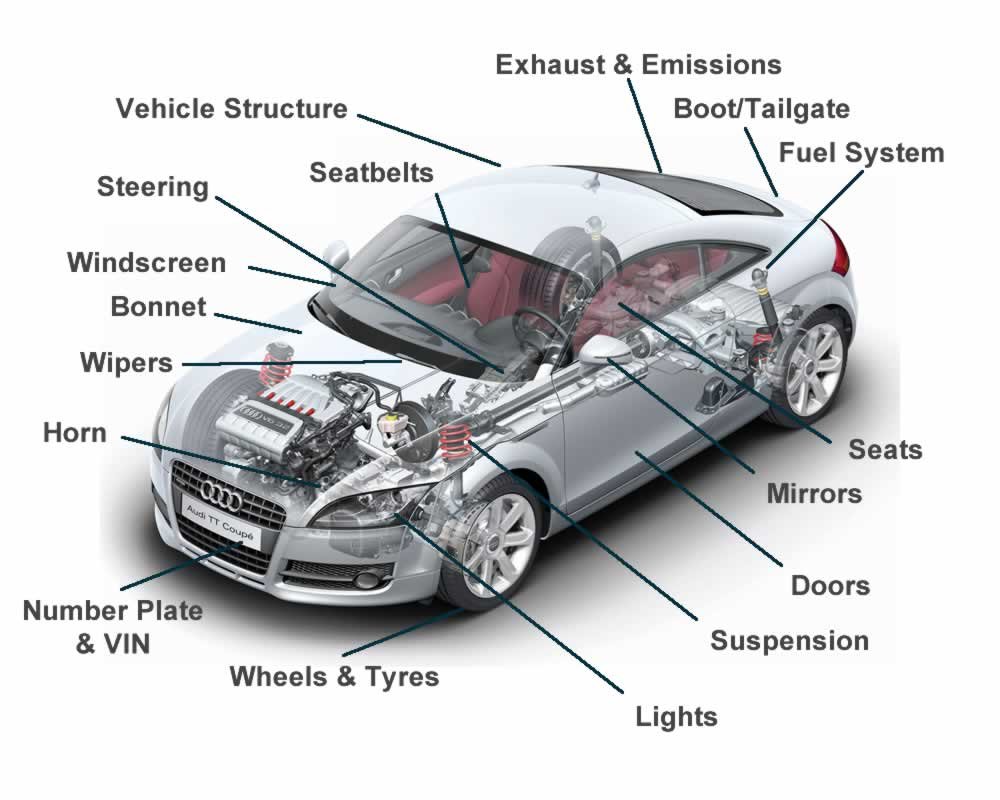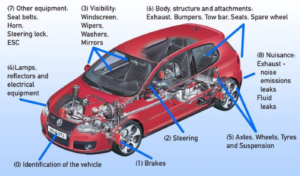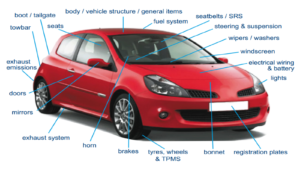
MOT's
Need an MOT? – All makes and models covered
SVS Manchester is one of the UK’s simple, fast and reliable company who’s aim is to keep peoples vehicles and the roads safe. We believe in passing our low costs on to you the customer making us one of the most competitive motor mechanics in Manchester
For more information about MOTs and the checks carried out as part of the MOT test, Please visit the GOV.UK website

Book your car for it’s MOT by filling in this form
What is an mot test
MOT testing is required by law on all vehicles in the UK that are 3 years old or more. The annual inspection follows strict criteria set out by the DVSA that determines if your car is fit for purpose and in roadworthy condition. The MOT test covers a broad range of vehicle safety checks which can only be carried out by an MOT garage with DVSA-approved examiners.
During the MOT test the nominated tester, a person accredited by the DVSA to assess your vehicle, will conduct a comprehensive inspection to ensure the vehicle is in roadworthy condition. However, it is not the same as having your vehicle serviced and the MOT test does not check the general mechanical condition of the vehicle. Also, the assessment is based on the condition of the vehicle on the day.
If the vehicle passes, the nominated tester will separately list and inform you of any ‘advisory’ or ‘minor’ items that will require attention in the near future so you can keep an eye on them.
If the vehicle fails, you may be entitled to a free re-test.
Please see below a breakdown of class 4, 5 and 7
Class 4 Mot:
- Cars (up to 8 passengers Seats) and Motor Caravans
- 3 Wheeled Vehicles (over 450kg unladen weight)
- Quads (max unladen weight 400kg- for goods vehicle 550kg and max. net power of 15kw)
- Dual purpose Vehicles
- Private Hire vehicles and PSVs ( up to 8 Seats)
- Good Vehicles (up to 3.000kg DGW)
- Ambulances & Taxis
- ( Taxis and Private Hire Vehicles may be subject to additional Local requirements)
- Private Passengers Vehicles and Ambulance
- ( 9-12 Passengers Seats)
Class 5 Mot:
- Private Passengers
- 13 – 16 Passenger Seats
- Vehicle And Ambulances
- More than 16 Passengers Seats
- (with 13 or more Passenger seats)
- Play buses
Class 7:
Mot Good Vehicles (over 3000kg up to 3500kg DGW)

what does an mot test involve
List of MOT Test Checks (May 20th 2018 update)
This is a description of MOT checks made during an MOT inspection.
It is designed to give you a better understanding of the MOT and to enable you to carry out some simple checks for yourself before taking your car for its MOT.
The following list of MOT checks will tell you which parts of your car are inspected, how the pass or fail result may differ from previous MOT inspections and tells you about some new items which have been added to the MOT Test.
The biggest changes will be to your MOT Test result document – MOT defects will now fall into one of three categories:
| Defect | Category |
| “Minor” defect – the item has not failed the MOT, but is a defect which should be fixed as soon as possible | Minor |
| “Major” ” defect – which is the same as a current MOT failure – the item must be fixed in order to pass | Major |
| “Dangerous” defect – which means an MOT failure, the item must be fixed in order to pass, and the vehicle should not be driven on the road until this has been done* | Dangerous |
Your car may pass with no defects at all, or with one or more ‘minor’ defects – it is still a pass.
If your car has one or more ‘major’ or ‘dangerous’ defects, it is a fail.
Additionally, your car may pass with no ‘defects’ at all, but still carry an ‘advisory’ note from the Tester if he discovers something which may not be part of the MOT Test, but nevertheless is something you should be aware of.
What if my vehicle fails mot
MOT test result
Your vehicle can either pass or fail the MOT.
If your vehicle passes the MOT:
- you’ll get an MOT certificate from the test centre
- it will be recorded in the MOT database
- You might also get a list of ‘minor’ or ‘advisory’ problems to monitor or fix in the future.
Mileage reading!!
The MOT certificate will show the mileage recorded at the current and previous 3 test passes.
Check the mileage on your MOT certificate when you get it. Contact the MOT centre within 28 days if you think it’s wrong. They’ll check the mileage and give you a replacement certificate if the original reading is wrong.
If you got your certificate more than 28 days ago, report the mistake to the Driver and Vehicle Standards Agency (DVSA) instead.
You’ll need proof of what the mileage was close to the time of the MOT, for example service receipts.
Email photos or scans of any documents to DVSA. You can also send copies by post.
Do not send original versions of your documents as they will not be returned.
Failing the MOT
Your vehicle will fail if the test result lists ‘dangerous’ or ‘major’ problems with your vehicle. You might not be allowed to drive until you fix the problems.
You might also get a list of ‘minor’ or ‘advisory’ problems to monitor or fix in the future.
If your vehicle fails the MOT:
You will get a ‘refusal of an MOT test certificate’ from the test centre and it will be recorded in the MOT database
Driving a vehicle that’s failed
You can take your vehicle away if:
Your current MOT certificate is still valid and no ‘dangerous’ problems were listed in the MOT
Otherwise, you’ll need to get it repaired before you can drive.
If you can take your vehicle away, it must still meet the minimum standards of roadworthiness at all times.
About the mot
The MOT tests some important items on your vehicle to check that they meet the legal standards.
It isn’t the same as having your vehicle serviced and doesn’t check its general mechanical condition.
The test doesn’t cover the condition of the:
- engine
- clutch
- gearbox
 Car parts tested in the MOT:
Car parts tested in the MOT:
These are some of the important parts of your car that will be checked in the MOT.
Body, vehicle structure and general items
These will be inspected to check that:
- They’re free from excessive corrosion or damage in specific areas
- There are no sharp edges likely to cause injury
Towbars will be inspected for:
- secureness
- condition
- inappropriate repairs or modification
The MOT tester will also check that:
- the 13 pin electrical socket is working correctly
- the speedometer is in good working order
- the engine mountings are secure
Fuel system
The fuel system will be inspected to check that:
- there are no leaks
- the pipes and hoses are secure and in a good condition
- the fuel cap fastens and seals securely
You should make sure that the key is available as the fuel cap will need to be opened.
Exhaust emissions
The vehicle will be inspected, depending on the age and fuel type of the vehicle, to check that it meets the rules for exhaust emissions.
Diesel vehicles
The MOT tester will refuse to test your vehicle if they think that the smoke test may damage your engine.
You should tell them at the start of the MOT if you think this may happen.
To reduce the possibility of damage and increase the chances of passing, you should:
- keep your vehicle maintained at all times
- have the camshaft drive belt replaced at the recommended intervals
- go for the MOT with a fully warmed up engine – it will produce less smoke and is safer to test
- not tamper with the governor settings
Exhaust system
The exhaust system will be inspected to check that:
- it’s secure and complete
- a catalyst isn’t missing where one was fitted as standard
- it’s without serious leaks and not too noisy
Seatbelts
The vehicle will be inspected to check that:
- the mandatory seatbelts are in place
- they are suitable for the vehicle
- they are in a good condition
- they work properly
- they are attached securely
The malfunction indicator lamps (MILs) or dashboard warning lights will be checked for the:
- air bags
- seatbelt pretensioners (which remove the slack from a seatbelt in the event of a collision)
- seatbelt load limiters (which release a small amount of belt when it’s too tight)
Seats
These will be inspected to check that:
- the driver’s seat can be adjusted
- all seats are securely fitted and that seat backs can be fixed in the upright position
Doors
These will be inspected to check that:
- the latch is secure in the closed position
- the front doors open from inside and outside the vehicle
- the rear doors open from outside the vehicle
- hinges and catches are secure and in a good condition
Mirrors
The vehicle will be inspected to check for the minimum number of mirrors, their condition and security. Indirect vision devices will also inspected.
Load security
The vehicle will be inspected to check that the boot or tailgate can be closed properly.
Brakes
These will be inspected to check:
- their condition, including inappropriate repairs or modifications
- their operation and performance (the efficiency test) – the wheels and trims aren’t removed as part of the test
- the anti-lock braking system (ABS) and electronic stability control (ESC) (where fitted)
The MILs or dashboard warning lights will also be checked for the ABS, ESC, electronic park brake and brake fluid warning lights.
Tyres and wheels
These will be inspected to check for:
- condition
- security
- tyre size and type
- tread depth
Spare wheels and tyres are not inspected.
Vehicles first used on or after 1 January 2012 will be checked to make sure the tyre pressure monitoring system (TPMS) MIL is working.
Registration plates
These will be inspected to check for:
- condition
- secure attachment
- colour
- characters correctly formed and spaced
Lights
These will be inspected to check:
- their condition
- operation, including high intensity discharge (HID) and light emitting diode (LED)
- the headlamps for cleaning, self levelling and security
- headlamp aim
- main beam warning light working
Bonnet
This will be inspected to check that it closes securely.
Wipers and washers
These will be inspected to check that they work properly so the driver has a clear view of the road.
Windscreen
The windscreen will be inspected to check for:
- condition
- the driver’s view of the road
Horn
This will be inspected to check:
- that it works properly
- it’s suitable for the vehicle
Steering and suspension
These will be inspected to check:
- their condition
- steering oil level
- they work correctly
- for inappropriate repairs or modification including corrosion to power steering pipes or hoses
- that the steering lock mechanism works properly
The MILs or dashboard warning lights will also be checked for the electronic power steering and steering lock.
Vehicle identification number (VIN)
The VIN will be on vehicles first used on or after 1 August 1980. Your car will be inspected to check that a single VIN is displayed, except on multistage build vehicles (eg van conversion, BMW, Alpina etc).
Electrical
Visible electrical wiring and the battery will be checked.
How often do you need an MOT
All vehicles 3 years old or more are required to have a valid MOT test certificate which should be renewed annually.
It is your responsibility to ensure your vehicle is examined every 12 months. You can find the expiry date of your MOT on your existing MOT test certificate and you can have your vehicle MOT tested up to 28 days in advance.
The expiry date on your new MOT is 12 months from the expiry of your old one rather than 12 months from the day you took the test, so as long as your MOT test is due in the next 28 days, you won’t lose any days for having your vehicle tested early.
What if my MOT has expired
Without a current MOT certificate, you will be unable to drive your vehicle lawfully or renew your road tax.
The penalty for not having an up to date MOT certificate could be a fine. Also if the vehicle is involved in an accident you may be asked to produce your MOT certificate. An insurance claim could be affected by the absence of your MOT, especially in the case of injury.
Recent computerisation of the MOT testing system by DVSA means police and mobile camera units can now check remotely to see if your vehicle has a current MOT.
Earliest date you can get an MOT
An MOT lasts for a year. The date it runs out is printed on your current MOT pass certificate.
You can get an MOT up to a month (minus a day) before it runs out and keep the same renewal date.
Example
If your MOT runs out on 15 May, the earliest you can get an MOT to keep the same renewal date for next year is 16 April.
You can get an MOT earlier, but the renewal date for the following year will change to one year (minus a day) from the date the vehicle last passed its MOT.
Example
Your MOT is due to run out on 15 May, so the earliest you can get it done is 16 April. However, you take your vehicle for its MOT on 14 April and it passes. This means that the MOT expiry date changes to 13 April the following year.
If the MOT has run out
You cannot drive your vehicle on the road if the MOT has run out. You can be prosecuted if caught.
The only exceptions are to drive it: to or from somewhere to be repaired or to a pre-arranged MOT test
Retests and repairs
In some cases your vehicle can have a partial retest for free or a reduced MOT fee.
Leaving your vehicle for repair
You only need a partial retest if you leave the vehicle at the test centre for repair and it’s retested within 10 working days. There’s no fee for this.
Taking your vehicle away for repairs
You can take your vehicle away if your MOT certificate is still valid.
If your MOT has run out you can take your vehicle to: have the failed defects fixed or a pre-arranged MOT test appointment
Taking it back for a retest the next working day
You will not have to pay again if you take it back to the same test centre before the end of the next working day for a partial retest
